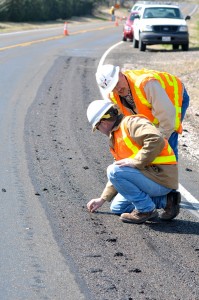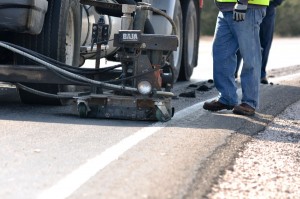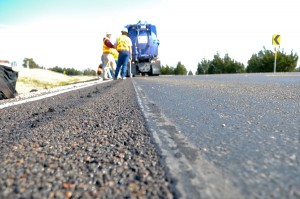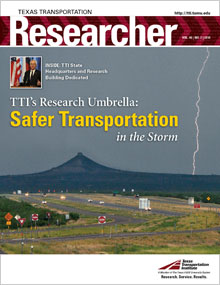
Summertime in Texas means rising temperatures, long days and the emergence of maintenance forces ready to take on approximately 186,000 lane miles of roadways. The Texas Department of Transportation (TxDOT) spends over $2 billion annually to maintain the state’s roadways, and seal coats are an important part of TxDOT‘s preventative maintenance program. But what happens when the maintenance needs maintenance?
A recent test demonstration led by Darlene Goehl, P.E., a pavement and materials engineer in the TxDOT Bryan District, sought to find a cost-effective option for correcting “bleeding” or “flushing,” which is a common problem with seal coats and surface treatments in Texas.
“Bleeding or flushing occurs when excess asphalt binder is pushed to the pavement surface, covering the aggregate,” explains Texas Transportation Institute (TTI)Research Engineer Cindy Estakhri. “What you will see is a black and frequently sticky surface, which can lead to a loss of skid resistance.”
The demonstration project was conducted on a half-mile stretch of road in Grimes County, Texas. The process involved using a truck called the “Blaster Vac” that sprays ultra-high-pressure water at 36,000 psi onto the flushed roadway surface to remove excess asphalt. The water and asphalt residue are then vacuumed up.
“This is the first time ultra-high-pressure water blasting technology has been used in Texas for treatment of flushed seal coats,” said Goehl. “We picked a test section that exhibited heavy flushing across the roadway, not just in the wheel paths. It truly is a worst-case scenario type of road that is able to give us a true measure of how this technology works.”

The treatment width of the Blaster Vac sprayer and vacuum deck is 2 feet, and after one pass the observers were able to notice a significant amount of excess asphalt removed from the roadway surface.
“One of my concerns was that the water would blast not only the asphalt, but also the aggregate down to the base,” said Goehl. “This test showed that not to be the case, and that the aggregate was not removed with the excess asphalt.”
The Blaster Vac demonstration is a first step toward implementation of findings from TxDOT research project 0-5230, a study about short-term solutions to “bleeding” asphalt pavements led by Texas Tech University Assistant Professor of Civil Engineering William Lawson, P.E.
In observing the Blaster Vac demonstration, Dr. Lawson noted that the ultra-high-pressure water cutting treatment not only helped to restore the macrotexture of the seal-coat by removing excess asphalt, but also improved the microtexture of the exposed seal coat aggregate. “This will further improve friction resistance for these applications,” said Lawson.

TxDOT will monitor the Grimes County test section to determine if water blasting is a cost-effective method to remove excess asphalt and improve the friction characteristics of the pavement.
“Certainly this test is encouraging,” said Goehl. “This technology has the potential to save the state time and money by performing maintenance on a roadway instead of having to do a full resurfacing of the pavement.”
